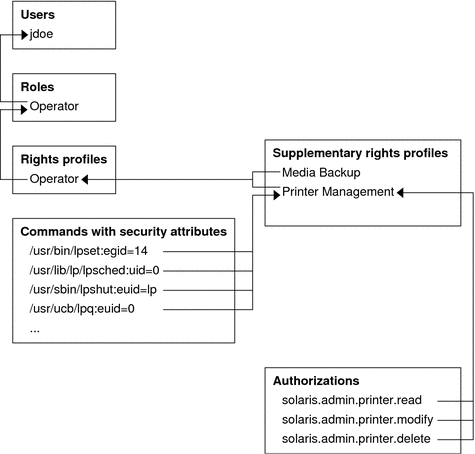Solaris RBAC Elements and Basic Concepts
The RBAC model in the Solaris OS introduces the following elements:
-
Authorization – A permission that enables a user or role to perform a class of actions that could affect security. For example, security policy at installation gives ordinary users the solaris.device.cdrw authorization. This authorization enables users to read and write to a CD-ROM device. For a list of authorizations, see the /etc/security/auth_attr file.
-
Privilege – A discrete right that can be granted to a command, a user, a role, or a system. Privileges enable a process to succeed. For example, the proc_exec privilege allows a process to call execve(). Ordinary users have basic privileges. To see your basic privileges, run the ppriv -vl basic command.
-
Security attributes – An attribute that enables a process to perform an operation. In a typical UNIX environment, a security attribute enables a process to perform an operation that is otherwise forbidden to ordinary users. For example, setuid and setgid programs have security attributes. In the RBAC model, operations that ordinary users perform might require security attributes. In addition to setuid and setgid programs, authorizations and privileges are also security attributes in the RBAC model. For example, a user with the solaris.device.allocate authorization can allocate a device for exclusive use. A process with the sys_time privilege can manipulate system time.
-
Privileged application – An application or command that can override system controls by checking for security attributes. In a typical UNIX environment and in the RBAC model, programs that use setuid and setgid are privileged applications. In the RBAC model, programs that require privileges or authorizations to succeed are also privileged applications. For more information, see Privileged Applications and RBAC.
-
Rights profile – A collection of administrative capabilities that can be assigned to a role or to a user. A rights profile can consist of authorizations, of commands with security attributes, and of other rights profiles. Rights profiles offer a convenient way to group security attributes.
-
Role – A special identity for running privileged applications. The special identity can be assumed by assigned users only. In a system that is run by roles, superuser is unnecessary. Superuser capabilities are distributed to different roles. For example, in a two-role system, security tasks would be handled by a security role. The second role would handle system administration tasks that are not security-related. Roles can be more fine-grained. For example, a system could include separate administrative roles for handling the cryptographic framework, printers, system time, file systems, and auditing.
The following figure shows how the RBAC elements work together.
Figure 8–1 Solaris RBAC Element Relationships

In RBAC, roles are assigned to users. When a user assumes a role, the capabilities of the role are available. Roles get their capabilities from rights profiles. Rights profiles can contain authorizations, privileged commands, and other supplementary rights profiles. Privileged commands are commands that execute with security attributes.
The following figure uses the Operator role, the Operator rights profile, and the Printer Management rights profile to demonstrate RBAC relationships.
Figure 8–2 Example of Solaris RBAC Element Relationships

The Operator role is used to maintain printers and to perform media backup. The role is assigned to the user jdoe. jdoe can assume the role by switching to the role, and then supplying the role password.
The Operator rights profile has been assigned to the Operator role. The Operator rights profile contains two supplementary profiles, Printer Management and Media Backup. The supplementary profiles reflect the role's primary tasks.
The Printer Management rights profile is for managing printers, print daemons, and spoolers. Three authorizations are included in the Printer Management rights profile: solaris.admin.printer.read, solaris.admin.printer.delete, and solaris.admin.printer.modify. These authorizations enable roles and users to manipulate information in the printer queue. The Printer Management rights profile also includes a number of commands with security attributes, such as /usr/sbin/lpshut with euid=lp and /usr/ucb/lpq with euid=0.
- © 2010, Oracle Corporation and/or its affiliates
